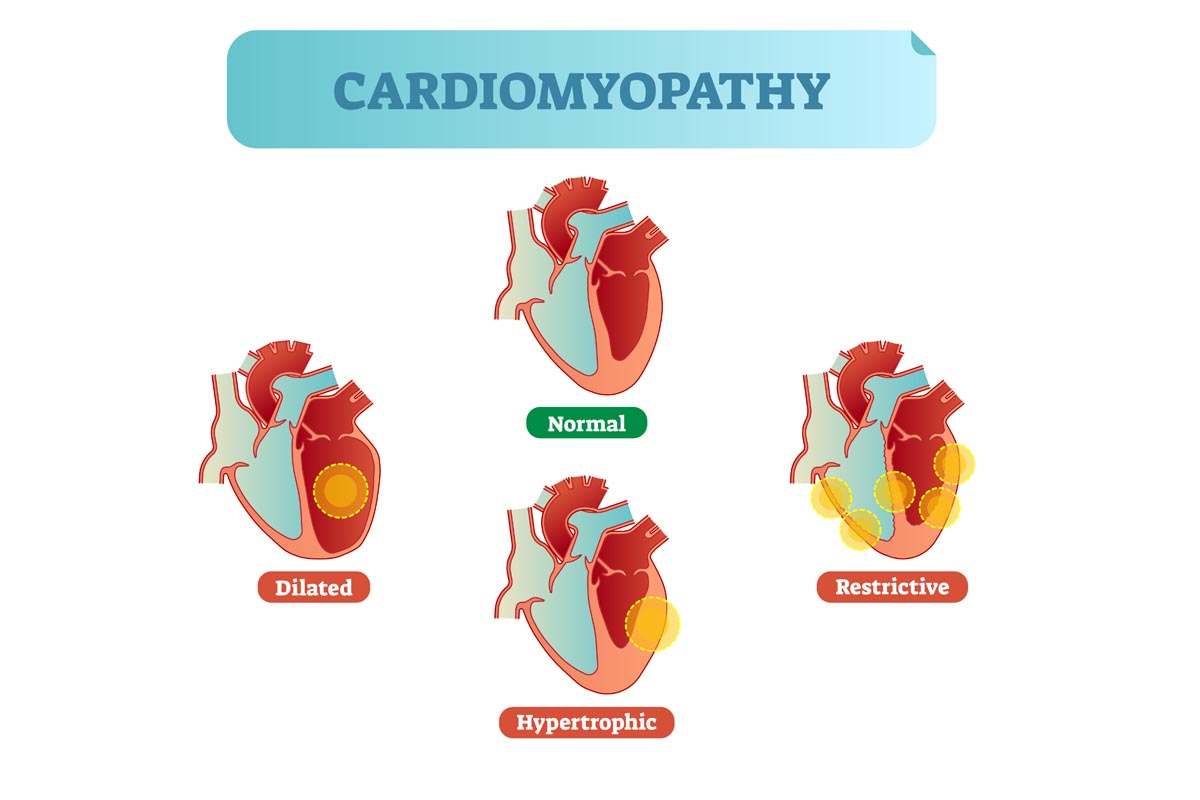The heart is a part of the circulatory system which is responsible for transporting oxygen around the body. It is susceptible to several disorders that may be congenital (present at birth) or develop later in life.
The cat’s heart is approximately the size of a plumb.
Composition of the heart
The heart is a hollow muscle composed of four chambers, and three layers, the outer (epicardium); the middle (myocardium) and the inner (endocardium), and is enclosed in a sac (pericardium).
The two sides of the heart are separated by a muscular septum: the right atrium and right ventricle, and the left atrium and left ventricle. The upper chambers are the atria, the lower is the ventricle. Atria are thin-walled and serve as receiving chambers, ventricles are thick-walled and serve as pumping chambers.
Valves are located between the four chambers of the heart. These valves control blood flow, ensuring one-directional flow. The right atrium receives deoxygenated blood which then flows through the tricuspid valve and enters the right ventricle. This contracts, pumping the blood through the pulmonic valve into the pulmonary artery, entering the lungs.
Blood is pumped out of the left ventricle into the aorta, passing through progressively smaller arteries until it reaches the capillary beds of the skin, muscle brain, and internal organs.
Coronary arteries carry oxygenated blood to the heart; cardiac veins remove deoxygenated blood from the heart.
Heart disorders in cats
Heartworm: Feline heartworm disease (FHD) is a serious parasitic infection caused by the nematode Dirofilaria immitis which lives in the pulmonary arteries, lungs, and hearts of cats. Heartworms are a type of roundworm, with adult heartworms reaching a length of 12 to 30 cm.
Heart murmur: An abnormal sound of the heart caused by several conditions such as hypertrophic cardiomyopathy. Sometimes it is innocent, with no known cause.
Cardiomyopathies (heart muscle disease): Cardiomyopathies are the most common cause of cardiovascular diseases in cats. Primary cardiomyopathies are when there is no known cause. Secondary myopathies occur due to infection, disease, or metabolic disease which affects the heart.
Myopathies are classified according to their appearance such as hypertrophic, dilated, unclassified (restrictive or intermediate). The most common form is hypertrophic cardiomyopathy which is a thickening of the left ventricular wall.

Congenital heart disease: Abnormalities either inherited or which developed during fetal development, congenital heart disease is much less common in cats than it is in dogs. The most common form in cats is a ventricular septal defect and atrioventricular valve malformations.
Acquired heart disease: These are not present at birth but develop at some point in the cat’s lifetime. They may be primary, or secondary to conditions such as hyperthyroidism or kidney disease.
How to check a cat’s heart rate
- To check the pulse, feel for the femoral artery which is located close to the surface on the inside of the thigh at the groin.
- I found it difficult to find the femoral artery to check the pulse, another method that I found much easier was to feel the heartbeat. To do this press against the rib cage over the heart. With the cat standing, feel the pulse just behind the elbow.
- Either way, count the number of beats in 15 seconds and then multiply by 4 to get the total number per minute.
Symptoms of heart problems in cats
Symptoms may vary depending on the heart condition, but common symptoms of heart problems include:
- Coughing
- Shortness of breath/panting, particularly after exercise
- Lethargy
- Weight loss
- Decreased activity
- Pale or blue-tinged tums
- Lameness in the rear legs
Diagnosis
In some cases, your cat will display no symptoms of a heart condition, and it will only be picked up during a regular checkup when your veterinarian listens to the heart with a stethoscope.
Diagnostic workup:
- ECG (electrocardiogram) – An echocardiogram is a test that takes a graphic tracing of the electrical activity of the heart. This can help the veterinarian diagnose heart disease, valvular or structural deformities or disturbances.
- X-Ray or ultrasound – To evaluate the size of the heart as well as look at the internal structures and blood vessels.
- Blood tests to check for underlying conditions such as hyperthyroidism, kidney disease, an infection that may have caused the heart problem.
Treatment
Treatment depends on the cause and may include:
Heartworm – A wait and see approach for asymptomatic cats. If the cat is displaying symptoms of heartworm infection then treatment may be necessary to kill the worm(s). But this treatment carries the risk of a dead worm causing a pulmonary embolism.
Heart murmur – As secondary heart murmurs are caused by an underlying condition, treating the cause is necessary. Primary heart murmurs require no treatment.
Cardiomyopathies – Treatment may include diuretics, blood-thinning drugs, and beta-blockers. Taurine supplements to cats with dilated cardiomyopathy.
Congenital heart disease – Most cases of congenital heart disease result in death within the first year of life. Surgical treatment is possible in some cases if caught early.

